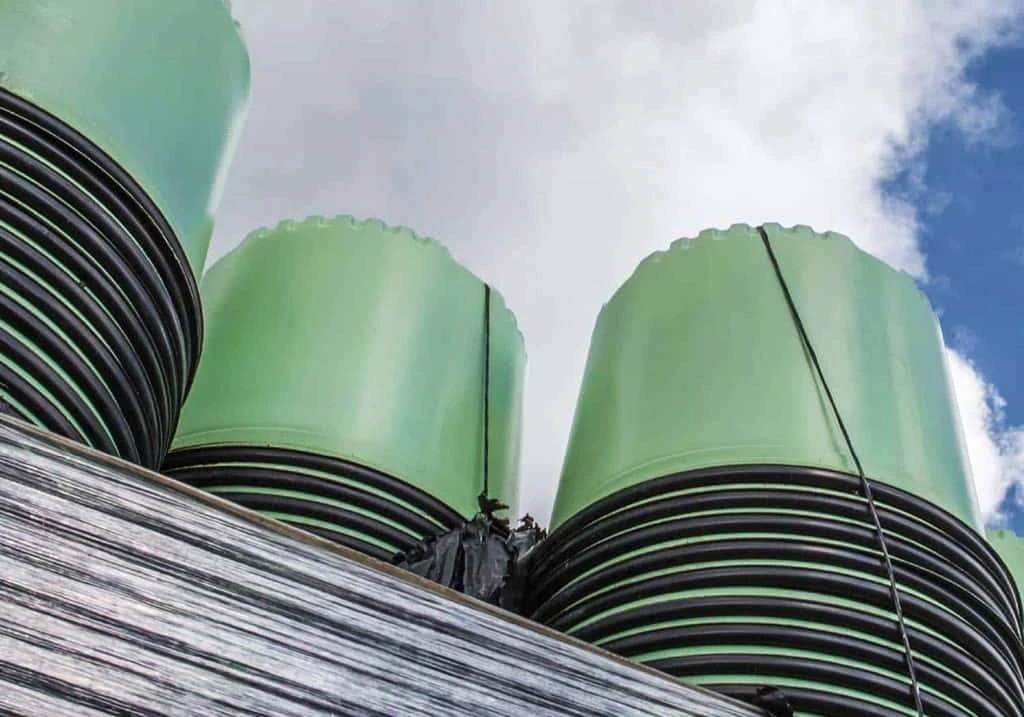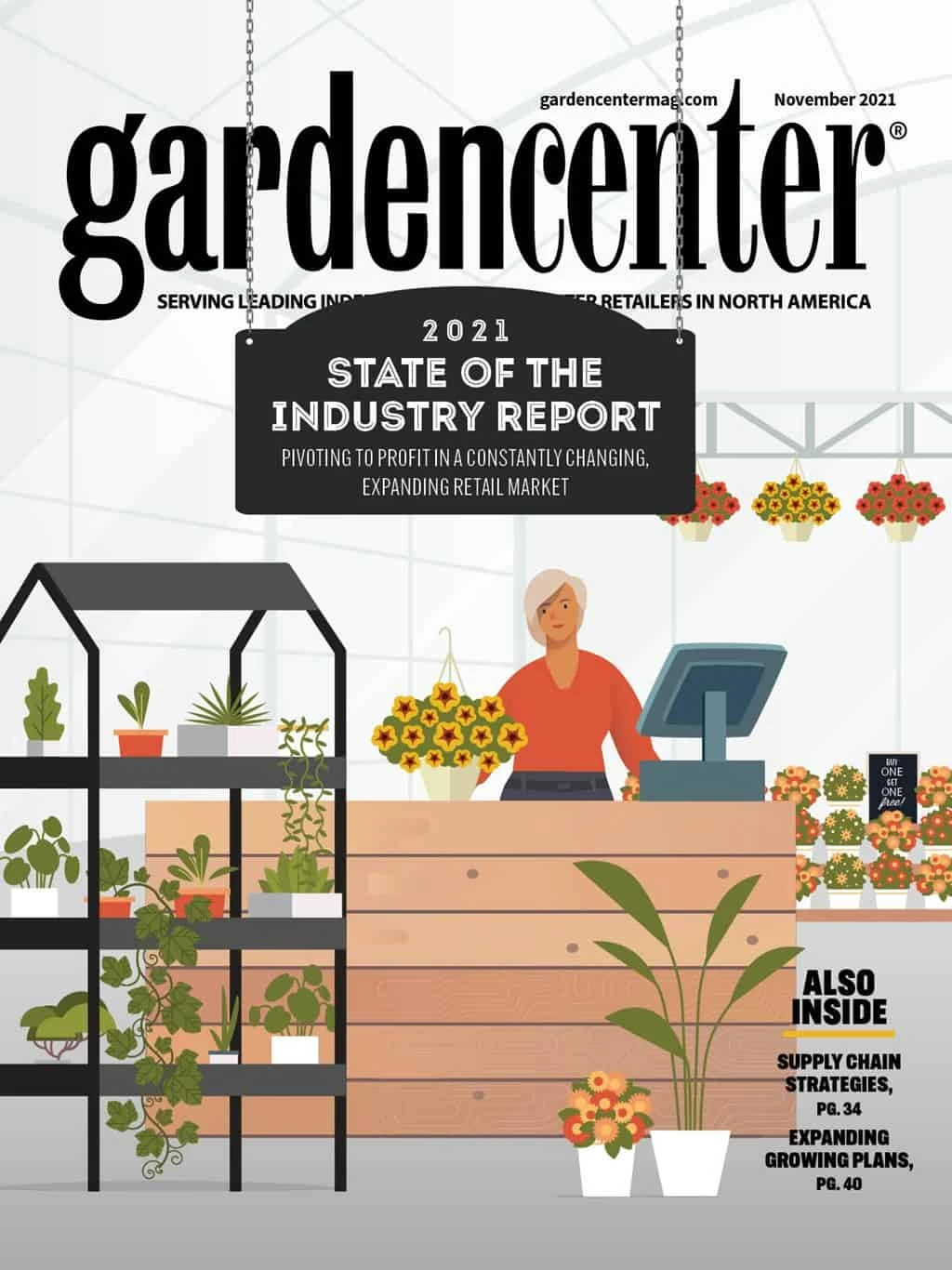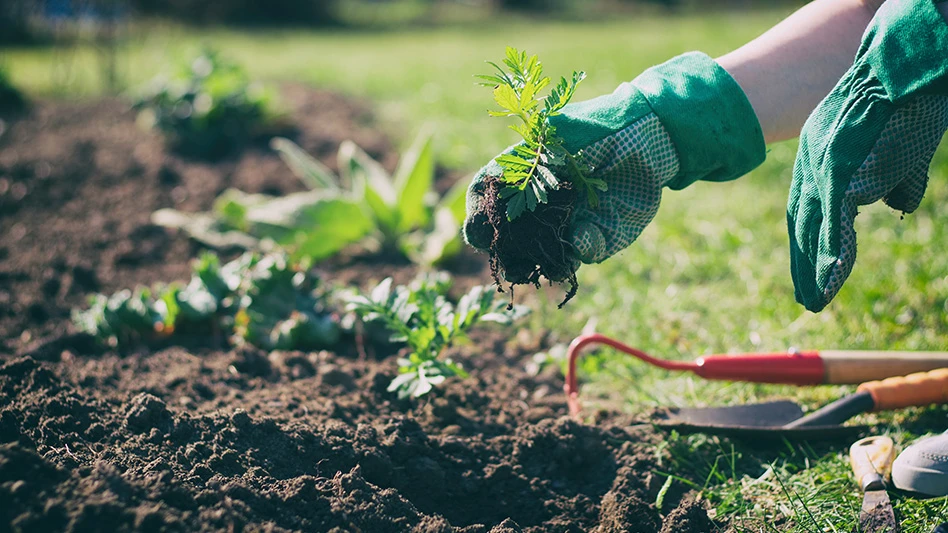

Nearly a year and a half after adapting to the demands of COVID-19, garden center owners have to rethink their business tactics once again as they face a different challenge: servicing the steady rate of customers with barriers to inventory. Now, as the industry fights the global tide of continued pot delays and plant scarcities, many owners have had to shift their strategies to prepare for the coming year and beyond.
Jeff Jones, owner and manager of Great Gardens in Torrington, Wyoming, says that the industry as a whole has been hit hard with tree and shrub shortages. Great Gardens grows many annual plugs and dormant and young perennials to finish. Luckily, he says, they’ve had no issues receiving plant materials. And while his supplier has reported seed shortages, Jones says it wasn’t a significant percentage of product. Occasional shortages and substitutions happen every year, which is expected.
Instead, he worries about plastic goods, specifically, 2.5-, 3.5- and 4.5-inch growing pots for plugs. Jones fears he may not acquire enough growing pots for plant materials. In addition, he says rumors are swirling amongst his industry friends that suppliers that accepted orders may not deliver pots until April — far too late in the season.

If it comes down to it, Jones might buy growing containers at a big-box store, but he says it’s unlikely he’ll need to resort to that. He’s also considering buying peat pots but is cautious due to a previous pot they test batched a few years prior.
“Years ago, I bought quite a few pots from a regional supplier that were made from old paper newspaper because I wanted to try something sustainable. And unfortunately, everything I grew in those pots died, but think I was only out $120 or so,” he says.
When the pandemic hit, Jones pounced at the opportunity to stock up on necessities, with a focus on seed. All vegetables they produce, along with 10-20% of their annuals, are grown from seed.
“I bought extra seed in 2020 because I could see some issues there. And then when I ordered seed again in 2021, I basically ordered seed for everything I need for next year. So, I don’t have concerns for myself as far as that because I looked forward quite a way,” Jones says.
Perennial problems
Rick Thomas, who co-owns Bethany Plants and Produce with his wife, Tammy, says they’ve had a tough time getting pots, perennials, Proven Winners varieties and hostas. Some of the plant materials they ordered earlier in the year were so delayed that Thomas didn’t receive them until October. He almost didn’t accept the shipment but decided against it because it’s a gamble to see what, if anything, will be available in the spring. In his experience, vendors take three to six months to fulfill orders, so Thomas purchased large volumes early this year.
“Normally I order a certain amount that I know I’m going to be able to pay for and then I’d order more as the season goes on. I value the credit that I have, and I try to coordinate that as we go along so I can pay for it,” he says.
One of his Michigan suppliers, Mast Young Plants, provided retailers with a discount if they placed orders by Nov. 1, which has helped keep costs down. Thomas notes that ordering early helps ensure the arrival of a consolidated shipment, which allows him to capitalize on shipping.
Located in the rural town of Reidsville, North Carolina, Thomas is hesitant to raise prices, considering they compete with other businesses in the Greensboro market. While they have increased prices a little, the business is eating some of the cost.
“You have to keep your price points at a certain area. Otherwise, you’re going to price yourself out of sales,” he says.
Thomas has had to get creative with substitutes for Proven Winners’ flowering shrubs and notes that most of the variations are selling tremendously well, along with shrubs with unique foliage. Of course, it helps that customers now are looking for different varieties instead of standard options.
“The thing I love about the Proven Winners line is you have lots of different flowering shrubs that are takes on some of the older shrubs,” he says. “For example, a lot of the old yards here have the old-fashioned sweet shrub and the newer varieties of it sell really well.”
“We’re not talking about 10% inflation; we’re talking about crazy inflation. I ordered a pallet and I got that cost down to 15 cents per pot, which is double what it was one or two years ago. But I’m in a situation where I think, ‘Well, I don’t care what it costs. I just need to have it.’”— JEFF JONES, OWNER AND MANAGER OF GREAT GARDENS
Sticker shock
Inflation is another issue that’s plaguing the industry. Jones says that 4.5-inch pots, which he sells the most of for annuals, have increased nearly double or triple the cost.
“We’re not talking about 10% inflation; we’re talking about crazy inflation,” he says. “I ordered a pallet and I got that cost down to 15 cents per pot, which is double what it was one or two years ago. But I’m in a situation where I think, ‘Well, I don’t care what it costs. I just need to have it.’”
But being located in Wyoming has its perks. Because they’re so close to Colorado, where most of their vendors are, Jones personally makes a day trip to pick up product, which saves him the hassles of shipping. Although some products, like onions, are shipped from nearby Iowa, the price has drastically increased. So to offset the cost, he raised the price of onions to $1 per bundle.
“It doesn’t bother the consumer too much, but I hate to do anything like that. That type of shipping on those things does make a difference. And sometimes you look at the number on the bottom of the invoice and it’s pretty surprising,” he says.
Karl Auwaerter, owner of Bayport Flower Houses in Bayport, New York, is also experiencing the effects of inflated freight costs. Along with their retail space, they operate a 2-acre growing area as well as a floral shop. Instead of playing the market as he did before, planning is crucial. Like Jones and Thomas, securing plastic production pots, and inventory in general, is a hassle for Auwaerter due to price increases.
“We’re trying to buy inventory that already exists because if we have cash flow, we’ll buy inventory at this year’s prices rather than next year’s prices,” he says.
While they’ve already placed their inventory orders for next year, he predicts there could be an oversupply in the industry two years from now, theorizing it could drive prices down in the future. However, he doesn’t plan on overshooting inventory for two reasons.
“One, buying inventory now is expensive. And I have a feeling that once all these container ships get unloaded, inventory might be cheaper eight to 12 months from now, when we’d have to restock,” Auwaerter says. “Two, I have enough to get through the main bulk of the spring, but if I have to restock I’m kind of banking on the fact that the price will be roughly the same, if not lower.”
He also ceased direct import container orders because the shipping and freight costs had quadrupled. While some “sticker shock” items have increased 10-25%, inflation and shipping have impacted the value of plants themselves because suppliers are selling it through frequency.
“When you’re dealing with Florida and their foliage plants, their prices have gone up a bit, but the plants have become smaller. Of course, the real sticker shock on that comes from the freighting and the availability of trucks,” he says. “So, you have to invest a ton more time and you have to be a little more savvy in the way you order so that you can the material can find its way up … but it’s a cost of doing business.”
Like Jones and Thomas, he’s also had to increase prices but has done so across the board. He tries to buy American if he can.
“I like to price off what I think the product will cost when I have to go out and buy it again. So I raised prices earlier because I needed the money to buy the new, higher priced item the next time I want to restock,” he says.
He strategically waited to raise prices until people had received their stimulus checks for two reasons: First, raising prices when people don’t have money creates problems. Second, by raising prices when people had more cash to spend, they wouldn’t need to raise prices again the following year — especially as customers’ spending habits become more frugal, he says. Nonetheless, Auwaerter remains optimistic and anticipates growth of 8-10% this year.

Explore the November 2021 Issue
Check out more from this issue and find your next story to read.
Latest from Garden Center
- Dümmen Orange North America celebrating 25th anniversary in 2025
- Illinois Landscape Contractors Association changes name to Landscape Illinois
- 2025 Proven Winners Horticulture Scholarship applications now open
- Leading Women of Horticulture: Arden Pontasch, North Creek Nurseries
- Spring Meadow Nursery's Freedom Shelley finds joy in plants
- Leading Women of Horticulture: Dana Massey, Plantworks Nursery
- Meet the Next Gen: Gabriella Blair, Star Roses and Plants
- Leading Women of Horticulture: Katie Dubow, Garden Media Group, and Aubry Field, Lizzy Blossom





